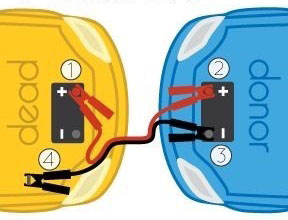Jumping a Car Battery Explained
Jumping a car battery is an essential skill of car ownership. It seems like car trouble seems to pop up at the worst possible times. It’s as if your car battery knows exactly the worst possible time to go bad. If you’re having trouble starting your car where the engine seems like it sputters but doesn’t crank jumping your car could be the solution.
When your battery is low and the car won’t start there are a few easy ways to get your car to turn on.
Jumping your Car Using a Portable Jumpstarter
Subscribe to this YouTube channel
This is the fastest and least complicated way to jumpstart your vehicle. It takes less than a minute from your car to go from a dead battery to one that will crank the car.
Jumping A Car Using Another Vehicle

The reason you attach the negative clamp (marked 4 above) to the metal of the car frame instead of the battery is that a dead battery produces hydrogen gas.
If the final negative connection is made on the negative battery post and a spark is created the battery can explode. That’s why it is suggested the final negative connection be made somewhere away from the battery.
Bonus: Get the Tools to Protect Your Car Battery. Click Here
Why Your Car Battery Dies
Your car battery performs worse in extreme temperatures, in cold temperatures around freezing the capacity of the battery drops 20%. Coupled with the increased draw from your starter motor and electronics because of the cold there’s a higher chance that you’ll run into car trouble compared to an average day.
The most important thing you want to look for in a battery is CCA which stands for cold cranking amps especially if you live in a place that sees below freezing temperatures for an extended period of time.
Your owners manual should tell you the right amount of CCA needed when selecting a battery, but it’s recommended you buy one with a higher CCA if you live in a colder climate.
Winter driving is more demanding on batteries due to increased usage of headlights because of shorter days and wiper use due to varying weather conditions. In some cases, motor oil gets thicker as a response to the cold and can make it difficult for the engine to turn over.
Hot temperatures also have a negative effect on car batteries. When the electrolyte in the battery is heated up it’s more likely to evaporate which causes the battery to never charge to the same level again.